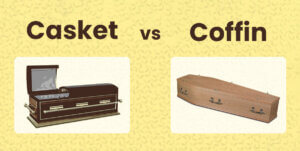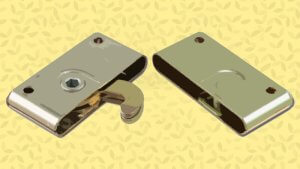While many animals have death rituals, humans are the only species to bury the dead in boxes. This is something we’ve been doing for tens of thousands of years.
And while most know of the practice of burying the deceased in caskets or coffins, fewer are aware that it’s common to bury a casket in yet another container called a grave liner or burial vault.
Grave liners and burial vaults are outer burial containers that protect cemetery grounds from shifting. But what’s the difference between them?
The difference is primarily one of design. Grave liners are porous concrete structures that allow water, air, and bacteria to interact with the casket and the deceased. Burial vaults are more expensive sealed structures that include a lined interior to protect the casket and body from outside elements.
Of course, there are a few other differences too.
Read on to learn more about this “box in a box” system.
In This Article
At a Glance: What Are Burial Vaults and Grave Liners For?
According to the Casket & Funeral Supply Association of America, grave liners and burial vaults are both known as “outer burial containers.”
They are typically made from heavy materials like concrete to encase the casket.
Some outer burial containers are placed in the ground before the funeral.
In this case, they have lids that are sealed before the grave is closed.
Others are lowered over the casket following the funeral.
The practice of using outer burial containers emerged in the 1880s with the goal of making grave robbers’ jobs harder. However, it soon turned out that they served another purpose:
Protecting Cemetery Grounds

Regardless of their material, caskets eventually decay (decompose or corrode), causing them to collapse.
This caving-in causes the ground to settle around the casket. This, in turn, causes depressions in cemetery grounds that make them unsightly and challenging to maintain.
Grave liners and burial vaults keep the cemetery safe and aesthetically pleasing.
Grave Liners vs Burial Vaults: What’s The Difference?
Grave liners and burial vaults are both outer burial containers, but the two are not the same.
What Is a Grave Liner?

A grave liner is a container designed to prevent the ground from caving in and shifting as a casket decays. Grave liners are typically constructed from porous concrete.
Some grave liners are “boxes” with six sides, including a bottom (with holes) and a lid.
Others are “coverings” with five sides, without bottoms.
Grave liners are exclusively meant to protect the cemetery grounds. They do not interfere with the natural decomposition process of the human body. Because grave liners have holes, water and soil can freely interact with the inside of the structure (and the casket too)
What Is a Burial Vault?

A burial vault is a sealed structure with six sides, including a lid and a bottom. They serve the same essential purpose as grave liners: To prevent the ground from shifting around the casket.
But they serve an additional function too.
Burial vaults are designed to keep the casket and body from interacting with the outside world. Unlike misleadingly marketed sealed caskets, burial vaults actually keep water and soil out — while keeping the decomposing body inside.
Burial vaults can be constructed with several different materials:
- Concrete, metal, marble, granite, or other high-quality materials form the outer layers.
- Burial vaults have interiors lined with waterproof polymer materials.
- The lid may be secured with butyl tape.
Some burial vaults are purely functional, while others have elaborate designs – like a sarcophagus.
A Type of Green Burial?
Some claim that protective and sealed burial vaults come with an important bonus.
Bodies are commonly embalmed. This keeps the deceased looking dignified and allows mourners to say their goodbyes at the funeral.
Unfortunately, the chemicals used in this process — including formaldehyde — are environmentally hazardous.
In the short term, burial vaults prevent these chemicals from seeping into the ground.
However, this does not last forever.
If burial vaults were hermetically sealed, they would eventually break due to pressure buildup from the gas released from the human body as it decomposes.
So no, burial vaults are not a type of green or natural burial.
Do Burial Vaults or Grave Liners Prevent Decomposition?
Graver liners do not prevent decomposition because they have holes that allow water in. They are just as good as a casket when it comes to the decomposition process.
On the other hand, burial vaults can prevent the decomposition of a coffin or casket. But they will not prevent or delay the decomposition of a human body.
While burial vaults may have watertight seals, we all begin decomposing the moment we die.
The truth is, because the body is sealed inside and gases and liquids have a harder time escaping, burial vaults may speed the decomposition rate up rather than slowing it down.
This is supported by the Federal Trade Commission’s funeral rule, which states to funeral service providers:
“You cannot make any representations to consumers that funeral goods or services will delay the natural decomposition of human remains for a long term or an indefinite time.”
How Much do Burial Vaults and Grave Liners Cost?
The basic grave liner, constructed without a bottom, cost around $700.
Burial vaults have more complicated designs, including various materials to create a tight seal. This makes them more expensive – burial vaults cost anywhere from $2,000 to $12,000 or more, depending on the materials, features, and design.
Is there a Difference in Size Between Burial Vaults and Grave Liners?
Standard grave liners and burial vaults – designed for average-sized adults (and average-sized caskets) – measure 30″ wide, 86″ long, and 24.5″ high.
Oversized burial vaults, which typically measure 36″ x 92″ or 42″ x 92″, also exist. These are intended for larger adults who require oversized caskets.
Coordinate with your funeral home if you need to find out what size burial vault or concrete grave liner is appropriate. This is important because, in some cases, a standard outer burial container may be able to hold an oversized casket.
Do You Actually Need a Burial Vault or Grave Liner?
Generally speaking, outer burial containers are not required in the United States at a Federal or State level. You’ll find the same situation in other countries.
However, many individual cemeteries require the use of grave liners or burial vaults.
This is because outer burial containers make the cemetery easier to maintain. They ensure that the burial ground maintains its orderly and peaceful appearance.
Of course, not all cemeteries have the same rules.
For example, green cemeteries are rising in popularity (Note: PDF Link).
These types of cemeteries promote the option of being buried in an environmentally friendly burial shroud, a simple wicker casket, or a cardboard coffin.
You can learn more about them here: Can You Be Buried Without a Casket? [Natural Burial Laws]
If you have any further questions about burial vaults, grave liners, or anything else beyond life, please feel free to leave a comment below or get in touch.











